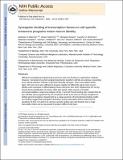Synergistic binding of transcription factors to cell-specific enhancers programs motor neuron identity
Author(s)
Mazzoni, Esteban O.; Mahony, Shaun; Closser, Michael; Morrison, Carolyn A.; Nedelec, Stephane; Williams, Damian J; An, Disi; Wichterle, Hynek; Gifford, David K.; ... Show more Show less
DownloadGifford_Synergistic binding.pdf (4.458Mb)
PUBLISHER_POLICY
Publisher Policy
Article is made available in accordance with the publisher's policy and may be subject to US copyright law. Please refer to the publisher's site for terms of use.
Terms of use
Metadata
Show full item recordAbstract
Efficient transcriptional programming promises to open new frontiers in regenerative medicine. However, mechanisms by which programming factors transform cell fate are unknown, preventing more rational selection of factors to generate desirable cell types. Three transcription factors, Ngn2, Isl1 and Lhx3, were sufficient to program rapidly and efficiently spinal motor neuron identity when expressed in differentiating mouse embryonic stem cells. Replacement of Lhx3 by Phox2a led to specification of cranial, rather than spinal, motor neurons. Chromatin immunoprecipitation–sequencing analysis of Isl1, Lhx3 and Phox2a binding sites revealed that the two cell fates were programmed by the recruitment of Isl1-Lhx3 and Isl1-Phox2a complexes to distinct genomic locations characterized by a unique grammar of homeodomain binding motifs. Our findings suggest that synergistic interactions among transcription factors determine the specificity of their recruitment to cell type–specific binding sites and illustrate how a single transcription factor can be repurposed to program different cell types.
Date issued
2013-07Department
Massachusetts Institute of Technology. Computer Science and Artificial Intelligence Laboratory; Massachusetts Institute of Technology. Department of Electrical Engineering and Computer ScienceJournal
Nature Neuroscience
Publisher
Nature Publishing Group
Citation
Mazzoni, Esteban O, Shaun Mahony, Michael Closser, Carolyn A Morrison, Stephane Nedelec, Damian J Williams, Disi An, David K Gifford, and Hynek Wichterle. “Synergistic Binding of Transcription Factors to Cell-Specific Enhancers Programs Motor Neuron Identity.” Nat Neurosci 16, no. 9 (July 21, 2013): 1219–1227.
Version: Author's final manuscript
ISSN
1097-6256
1546-1726